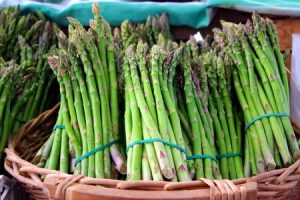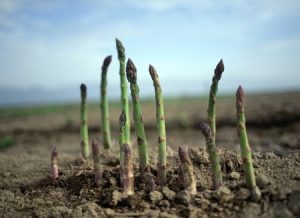
Asparagus remains one of the great delicacies of the dining table and when in season, we cannot get enough of it. It is at its finest in flavour when cut straight from the garden and boiled lightly, served with butter and presented in seried rows on the plate. It is extremely easy to grow if the conditions are right but requires space !
History
Garden asparagus is cultivated from a wild form Asparagus officinalis, a plant native to Europe, northern Africa and central Asia that has been used since ancient times, for cooking and medicinal purposes. The Egyptians had grown it extensively but it was the Romans who turned its presentation into an art form and they first domesticated this lily for growing throughout the empire. The ‘spears’ are the young emerging shoots which are cut before the fern-like foliage appears.
It thrives best on well-drained soil and in raised beds particularly where the sun can bathe it. Generally, 10 plants produce 100 spears in any season which seems plenty but only when the plant has matured. No spears can be cut for two years at least after planting but the wait is worth it.
Cultivation Of Asparagus
The asparagus bed lasts many years. It is a good suggestion from many experts to improve the soil with a bucket of compost or manure every square metre. Lime is added if required to raise the pH to 6.5-7.5 when grown on acidic soils. The chosen ground should have been free of asparagus from previous years but I have, with diligence, been able to grow asparagus on the same ground for a number of years and cleared it on previous occasions.
The plot needs to be weed free so careful digging and removal of any competing growth especially perennial weeds is a must.
Seeds can be sown any time but the best and quickest results are obtained from crowns which are dormant plants, about one year old. These yield the spears in a couple of years. Avoid dried out crowns on display – the freshest possible give the best results.
Asparagus is actually from the coast and grows well on grassy sand dunes so a well-drained soil is needed. Plant the crowns in a wide shallow trench (30cm (12cm) wide and 20cm (8in) deep). Mix in well-rotted manure and compost to the base of the trench and cover the base with a 5cm layer of excavated soil. Add a generous amount of grit to the trench base by the way if gardening on heavy clay.
Form a 10cm (4in)-high ridge of soil along the centre of the trench using a hoe. Place the crowns on top of this ridge: the crown should have its ‘eyes’ uppermost with roots draping down evenly on either side. Plant successive crowns leaving 30cm (12in) -45cm between each. Leave about 1 m (3ft) between any trench rows. Stagger the plants in adjacent rows. Cover with excavated soil to about 5cm (2in) so that only the tip of the crown shows. If the soil is dry, water in and mulch. Firm the soil down. Any weeding should be carefully conducted to avoid damaging the shallow roots.
Growing On
Add more soil as the asparagus stems grow, aiming to completely fill the trench by autumn. Keep the plants as well watered as possible.
Hand weed to continually remove persistent weeds and even use a black plastic covering in winter to reduce their impact before a thorough clearance. Mulching in winter with weed-free compost discourages weeds too and helps to provide much needed nutrients.
Every spring, apply 100g per sq. metre of general fertiliser including fish, blood and bonemeal, and again after harvest if any growth is weak. Keep upright with stakes and string, and look carefully for asparagus beetle.
Asparagus produces male and female plants so the flowers are one sex or the other. Modern cultivars, generally F1 are all male because they are more vigorous, prolific and generate better quality spears because they cannot form seeds. Female plants, which have the berries, appear in so-called all-male cultivars, and often make-up about half the plants in the mixed sex cultivars. Generally, the female plants and seedlings are removed.

Harvesting
No spears can be cut in the first year because the roots need to be well established and only harvest a few in their second year if desperate. I leave until the third year when I cut the first ones to appear in mid-April and finish harvesting at the beginning of June. When the beds are well established, cutting can last for 2 months roughly. Slice off spears with a sharp knife just below the soil before they exceed 18cm tall. It can mean cutting every few days otherwise the spears become too thick and woody like rhubarb.
I allow a few spears to mature into their feathery foliage so that I know where they are and to recover the plant. If the foliage is allowed to yellow in autumn before cutting it down to soil level, resources will be transferred to the roots to boost spring cropping. The foliage is essential to build up reserves for future crops which is one reason why beds can be exhausted by over-cutting of spears. It is thought a bed can last for 20 years if not longer.
Asparagus Cultivars For Growing
‘Connover’s Colossal’ (AGM) Cheap seed but not all-male. Older variety
‘Lucullus’ – classic old variety but largely being superseded because of its non all-male situation.
‘Gijnlim’ F1 (AGM) All-male plant, popular and reliable.
‘Guelph Millennium’ F1 (AGM) An all-male asparagus which matures later. It has exceptional vigour and delivers great yields. perfect in combination with asparagus ‘Mondeo’ as it crops later. grows well in a variety of soils and is perfectly suited to our climate. Is especially useful in cold gardens .
‘Mondeo‘ A very impressive, very early, all-male hybrid asparagus which produces excellent yields of juicy spears. Suitable for harvesting as white or green spears.
‘Pacific purple‘. A New Zealand variety which has been bred for its purple spears and appears during mid-season. Is said to be sweeter in fact one of the most delicious, more tender and higher in pigment antioxidants than the green types. A high yielding form. Apparently it is so tender it is eaten raw.
Problems
Asparagus beetle (Crioceris asparagi) : The adult beetles and their larvae will readily strip off the bark and foliage. These appear after the asparagus harvesting season so they wont be such an issue in the current season. It is the following year that they can get out of hand. So do not be complacent ! next year’s crop could be at risk. The beetles are slender in black, white and red livery and between 6 and 8mm in length.
The larvae are grey with a slug appearnce. Both adults and larvae chew into remaining spears and as the season progresses, feed on the foliage and bark of the stems. This damages any growth and turns the tops of the plant a ghastly yellow.
Make sure you don’t affect next season’s crops by leaving them. The beetle will often be visible as it crawls up the stem. Just nip it in the bud so to speak with an early swift removal.A slight infestation is manageable by either hand picking but or if too onerous use an organic solution like a pyrethroid insecticide. When using pyrethrum please avoid spraying nearby flowers so that visiting pollinators like bees are not compromised.
The beetle can overwinter where the adults seek shelter before emerging again the following spring. To combat this just burn the old stems at the end of the year. Keep surrounding areas tidy and weed-free.
Frosts & Sharp Cold Spells: Spears are distorted by extreme cold weather and will simply not emerge with the tips below the surface until the weather warms up. Cloches and fleece will protect only from light frosts.
Slugs and Snails: These eat young shoot tips. Remove with bait or organic methods when they are active at night and during rain.
Violet Root Rot: A problem when the roots are too shallow. It is not an issue if asparagus is planted deeply and their growth is managed properly.
Leave a Reply